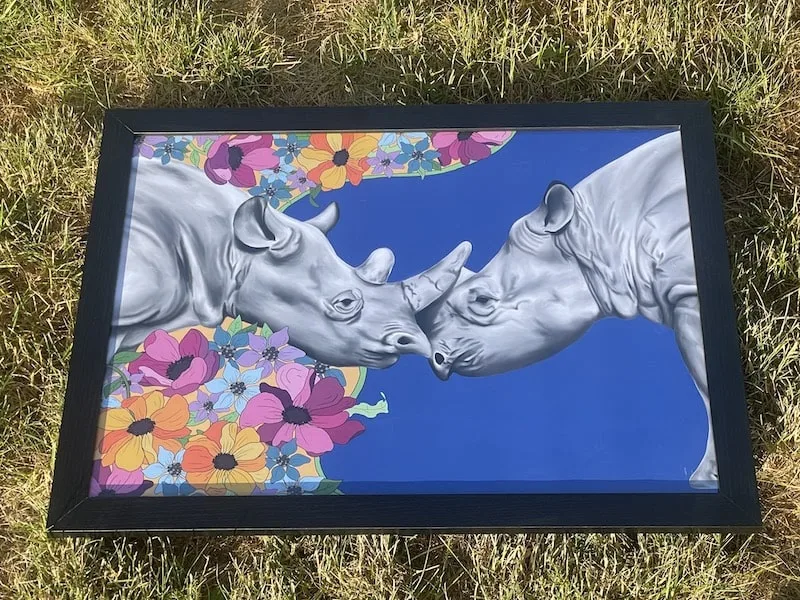As an artist, I know the feeling of completely losing my creativity because the pressure of creating a great piece of art for my business became too overwhelming. I know the feeling…really well.
It would honestly get to the point where I would stop making art altogether until I could regroup, refocus on my artistic creativity, and bring balance back to my art routine.
Here are some tips for how I learned how to balance making money as an artist without losing my creativity.
This post may contain affiliate links, which means I may earn a commission if you decide to purchase through my links.
1. Can You Sell Your Art Over and Over Again?
It can get exhausting to constantly feel the pressure of creating new and inspired art all the time. Sure, this is why we love being artists, but having some wiggle room is nice too.
While this may depend on your business model and approach to selling art, I like to consider whether there’s a way to bring in recurring revenue.
One of the ways I do this personally is through print on demand. Printify, Printful, and Gelato are some of my favorite platforms to check out! They let you upload your work and have it printed on a variety of products.
I LOVE ordering prints of my digital art so that I don’t have to fuss with my own printer. I also love that my prints can be sold over and over again without hassle.
Here’s a print I ordered from Gelato!

Having a repertoire of art that can be sold over and over again can relieve some of the pressure of creating brand new art all of the time. It’s a way to diversify your offerings while also keeping your creativity in tact.
If you’re interested in jumping into the world of Etsy, check out my article on print on demand platforms that integrate with Etsy.
2. Do You Know How Much Art You Need to Create?
Whenever I would feel pressure from creating new art, I would get caught up in the overwhelm in an amorphous way. Once I sat down and actually looked at the amount of art I needed to create, I could create a plan for it that I felt confident about.
I know that scheduling and planning sounds like the opposite of creativity. That said, there are times when it’s helpful to actually see and understand what we have on our plates so that we can plan accordingly.
Personally, I tend to turn a small speck of snow into a giant snowball. Actually writing down my artistic goals and projects can help me plan around them, schedule for them, and make me feel less overwhelmed about completing them.
3. Are You Still Enjoying Art?
When I started selling my artwork, it was easy to turn my “fun art” into “stressful work.” This was a creativity squasher to say the least. It just wasn’t fun anymore in the way that I wanted it to be.
In order to deal with this and bring my love for art back, I started to plan times that were solely focused on having fun with art.
I would find a Skillshare class on a random topic and let myself have fun with it. To be clear, I would try to find a class on something new and exciting – not on something that I knew I needed to work on. The goal was just to have fun.
Luckily, Skillshare has SO many different types of classes that this wasn’t hard. It actually became one of my favorite routines and did wonders for helping me reconnect with my love for art outside of the business of it.
This digital marbling class is one I really enjoyed!

If you’re struggling to bring back the creativity to your art business, try dedicating some time to having fun with it. Just fun. No pressure to create something that sells. Just fun.
4. Do You Actually Need to Be Creative Right Now?
When I create art, I struggle with feeling creative; yes, the feeling of it. If I don’t feel creative, I struggle to get into the groove and create art.
Overtime, I’ve learned to let this go. Just because I’m not feeling creative doesn’t mean I’m not creating great art. It just means that I’m not having mind blowing innovations, which is impossible to do 24/7 anyways.
Realizing that it’s not practical to feel creative all of the time actually helped me streamline my workflow. When I wasn’t feeling creative, I would work on the more technical aspects of my work.
When I was feeling creative, I would let myself run wild with my artistic ideas.
Planning my artistic tasks according to how I was feeling helped me stay productive, while also relieving the pressure to feel creative all of the time.
Making money as an artist sounds fun, and it definitely can be! But, it can also come with challenges. I hope these tips have helped you gain some balance around your art business so that you can bring the creativity back to it again.

Diana has been an artist for over 27 years and has training in drawing, painting, digital drawing and graphic design. Diana’s latest obsession is digitally drawing with Procreate and Procreate Dreams. Diana has experience selling her art across a number of platforms and loves helping other artists learn how to make money from their art as well.
